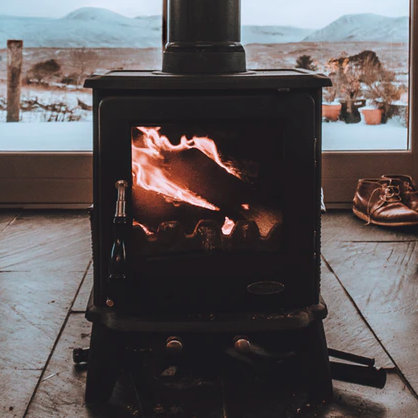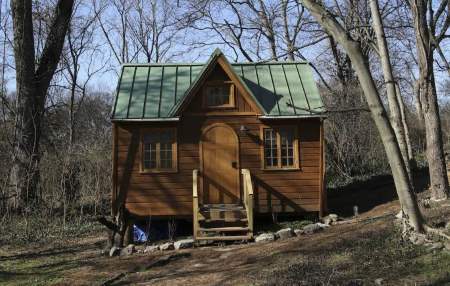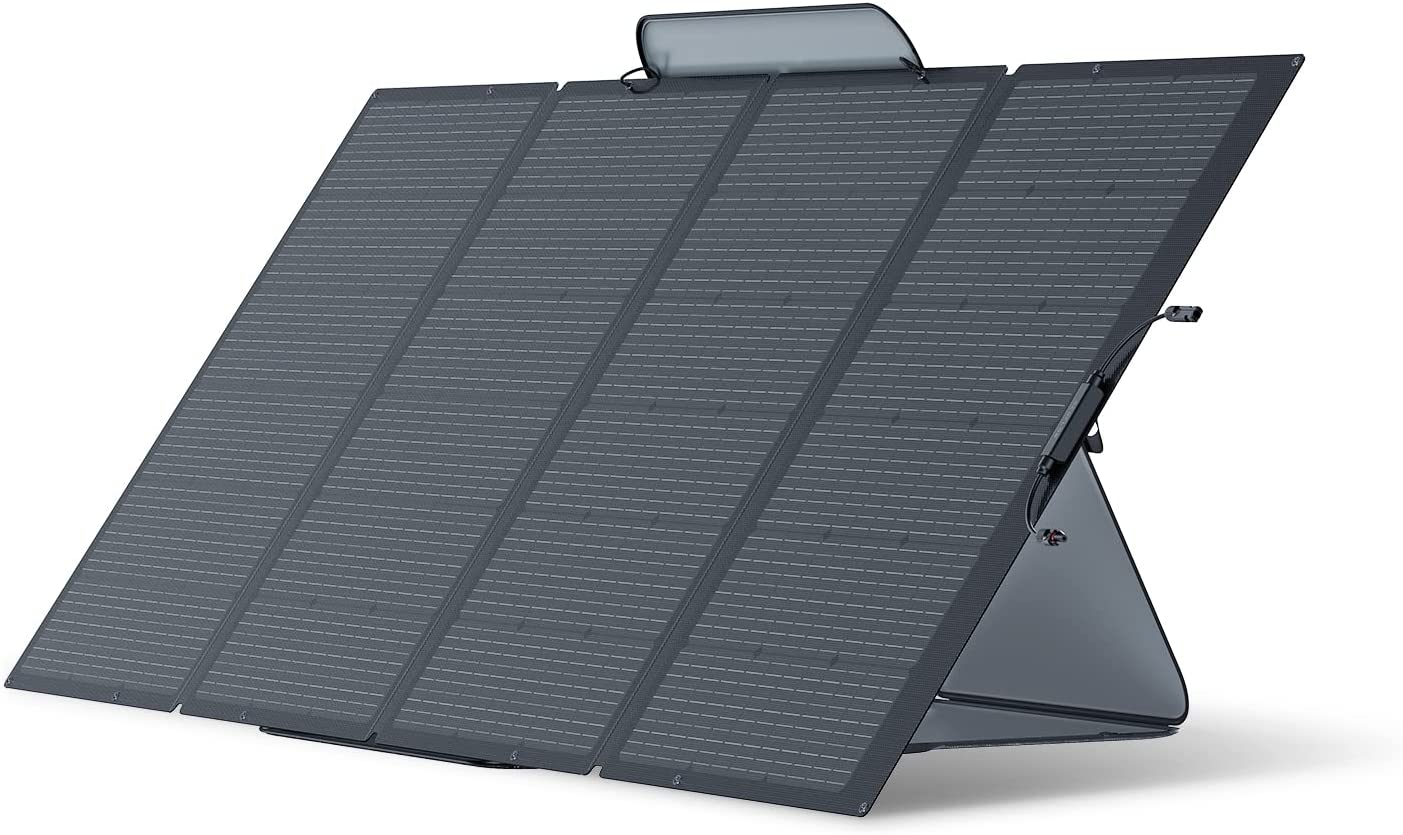
How To Truly Go Off-Grid With A Tiny House: No Half Measures
When working out where you park your tiny house, you have two options: live on-grid (‘connected’) or off-grid. On-grid involves being hooked up to fixed electric, water and sewerage supplies, and possibly a gas supply – like a standard house. Off-grid is the opposite of this: not having fixed utility hook-ups, and instead having to be self-sufficient sources for water, electric and gas. Whilst this might sound like a nightmare for some people, it is a dream for others.
Going off-grid with your tiny house involves building with the right materials (a steel frame can be best), using eco-friendly appliances and ensuring you have self-sufficient sources of water, electric and heating.
Construction Considerations
When building your tiny house, do not instantly opt for a wood frame – there can be some issues with this, and other building materials can actually be better. We take a closer look at these considerations below.
Wood
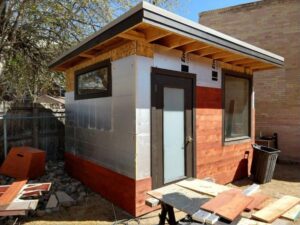
Building a tiny home out of wood can impact your off grid tiny house in a variety of ways. For example, builders must ensure the lumber they use for framing is absolutely cured. Lumber from big-box retailers, for instance, often contains moisture. Over time, as the wood dries, it warps. This warping can wreak havoc with a wall, or it can pull away from a nail or bolt. Living off the grid means, in part, remaining off grid, so repairs could easily require you to head back into the nearest town and fix the problem, which is not quite what you want.
Additionally, building out of wood will actually reduce your insulation’s R value. The R value in insulation is a rating of its ability to perform in various climates and temperatures. Wood, rather than steel, can reduce its effectiveness.
Finally, building from wood increases the weight of the tiny home. In high winds, this extra weight can prove beneficial. However, if you pull the tiny home on a trailer (i.e. so you can transport it), wood can require you to have a more expensive vehicle with a higher tow rating. The end result will be higher fuel costs.
Steel and Aluminum
Framing a tiny home in steel or aluminum can end up reducing the house’s overall weight by up to 60 percent. Additionally, it offers better fire protection. In terms of keeping you warm in the winter and cool in the summer, insulation performs as it should without its R rating leeching into the wood.
One thing to consider when framing a tiny home with steel or aluminum is that in terms of construction, a steel or aluminum frame also allows for more precision. More precision sounds good, but you have to ensure that there are plenty of air vents built into these types of structures because small structures, such as a tiny home, should not be completely air tight. If you attempt to live in a perfectly air-tight home, the best case is that living in the tiny house would feel uncomfortable… but in the worst case, you will eventual breathe all the oxygen and find yourself in a dire situation.
In terms of design, the ideal off grid tiny house should not look much like a traditional home shaped like a box and a roof. This is one mistake manufacturers often make when building such houses in that the final results often look like tiny cabins. Instead, for purposes of aerodynamics, it should be built like a lean-to on the facing long side. Moreover, the forward-facing side toward the truck should have an elevated area for a bed, and the roof over the bed should involve a slight angle for better wind handling and fuel conservation. Additional design shapes include incorporating a variety of angles such that the entire structure is curved rather than square. This type of design can withstand very high winds.
In terms of living off grid, this angular design also allows solar panels to be installed at an angle to collect the most possible light.
Trailer
The trailer is both the key to a tiny home and the limiting factor for its size. For instance, a trailer is what allows you to keep the tiny home mobile, and this mobility keeps it from being classified as a house, which subjects the owner to a variety of building codes and local ordinances. When selecting a trailer, you should pick one that rides low because it creates a lower center of gravity for safer towing. Additionally, a low trailer or one with a drop hitch can allow you to build a slightly taller house for more head room.
Weight
Part of the attraction of tiny homes is the financial independence, and the weight of a tiny home is one of the most overlooked obstacles to achieving such independence. For instance, additional weight requires a truck with a stronger tow rating, which often translates into a more expensive truck. Expensive personal vehicles cost more to license and insure, reducing your financial ability to be strictly off grid.
Best Off-Grid Appliances
Freezer versus Refrigerator
Most people design a tiny home as a replica of a traditional home–only smaller. There are plenty of mainstream products to choose from for a refrigerator, a microwave, or an over-sized television. Although this type of arrangement is nice, a better arrangement is to design something leaner.
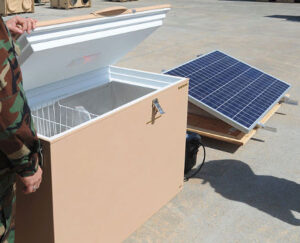
For instance, an off grid tiny house will, ideally, only have a freezer. Although people are accustomed to having a refrigerator and a freezer, this way of thinking does not suit the goals of someone really wanting genuine off-grid living. For instance, having only a freezer will draw less energy than having both. Although you might think having a refrigerator-freezer combo will work, this choice serves short-term needs more than it serves long-term survival and independence.
A refrigerator, for example, provides immediate convenience by providing access to cool perishables. A freezer, however, provides for the future by extending the shelf life of foods, drinks, and other perishables. This ability to look forward to the future increases your chance of successfully living off grid.
In terms of a refrigerator, you can adopt various ways of thinking that help your situation. For instance, instead of looking at milk as something that pours, you can store it in modules. Instead of storing an entire gallon, you can cut a half-gallon of frozen milk into slabs, like slices of bread. To store your milk, you simply need to place each slice of milk into a bag. When you need one, all you need to do is thaw it out. The same strategy can be used for any liquid or food. Sub-sections of food allow you to better ration your food and store it more effectively. Although this type of preparation requires some initial work, it ultimately eliminates the need for refrigerators.
Finally, you can get an off-grid freezer for a few hundred bucks. Even better, you can purchase a solar freezer. At $1,200, a solar freezer is more expensive, but it will be more suitable to off-grid living.
Oven
In terms of cooking, having a microwave might be convenient, but it is really just another way to suck electricity from limited resources. For any off grid tiny house, a Herc oven is the only cooking item you need inside the home. A Herc oven consists of an oven with some heavy-duty framing and insulation such that tea-light candles are sufficient to cook bread, meats, or other meals best prepared hot. Tea-light candles can be bought in bulk and stored in the loft (or a cupboard if you find the room). A flint-strike, permanent match is very inexpensive and eliminates the need for matches. With this type of oven setup, you can easily cook a hot meal without having to rely on electricity.
We have an article on best ovens and stoves for tiny homes, check it out!
Lighting
Large, storm-grade windows are the best solution for lighting and wind protection. They can withstand hurricane-grade winds, and they allow you to enjoy the largest volume of natural light. For night time, you can use solar-charging LED lights that will provide safe lighting that candles cannot provide.
For washers and dryers, visit our article to see more.
Pseudo Off Grid versus Genuine Off Grid
We have previously covered how you can live in a tiny house without a permanent water source, by – for example – picking up water in bulk and storing it away. Whilst this sounds good, you are still tied down to the grid because you need to make regularly trips to get water (and electric/gas sources too). We call this pseudo off-grid. The alternative is to setup your water, electric and heating needs by being truly and genuinely off-grid – which we explore below.
Electricity: solar panels
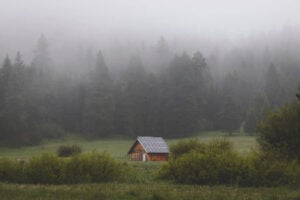
The typical off grid tiny house will measure somewhere between 94 inches wide and 20 feet long. Solar panels typically measure between 36 inches wide and 72 or so inches long. At a minimum, your home will require a minimum of 1,200 watts. A few 300-watt panels or a dozen 100-watt panels will do the trick. Because of the spaces involved, either type of watt configuration will fit comfortably on your tiny house.
The reason for the 1,200-watt minimum is that a window air-conditioning unit will use 1,000 watts. You will appreciate the cool air on an otherwise insufferable afternoon. Additionally, if you purchase a unit that also provides heat, your solar panels will be able to handle much of the load, keeping you both cool and warm.
Heaters
For your daytime heat, you should build a passive solar heater out of either aluminum cans or wire mesh. Because you can always park your tiny home’s primary window toward the south, you can enjoy the rather intense heat these types of heaters provide. Because a passive solar heater can tuck into your window, it can serve as a seasonal solution to daytime heating. After the cold season ends, you can remove it from the window and put it into storage.
For heat during the night, abundant insulation and shade can solve much of your problems. However, for extreme cold, you might consider installing a small wood stove. Doing so allows you to vent the smoke out a portable chimney and enjoy the heat from a log off the land.
Another strategy for staying warm is to use an arctic sleeping bag. Such a sleeping bag will handle extreme weather, and once the bad weather clears, you can always relocate to a slightly warmer climate.
Water
Relying on such things as RV water sources equates to pseudo off-grid living. By definition, an off grid tiny house should be able to sustain its own water needs, and the way you do this is by parking on your own property with a well drilled on it. Additionally, you should reserve nearly 100 percent of the area below your cabinets for the largest water tank you can afford. Backup tanks are also recommended. Check out our tiny house water guide for more details on this.
For drinking, if you do not have a well, you should have the tanks hooked up to a food-grade hose and a water pump. You can then pump water from a lake, river, or stream. Doing so provides you with natural water – but it is most likely replete with bacteria. As a result, the next step is to purify the water via an iodine system or charcoal system. You can also boil water and filter it. Finally, you can use a water-purification tablet if you are uncertain of the water’s purity. Because water storage is a key component of off-grid living, you will also need some water test strips that can test the pH of the water.
Sustainability: Extra Room From Efficient Design
Because the above suggestions leave room where the refrigerator, microwave, and heating ducts would usually go, you will have more room for living space, water storage, or fuel cells to store harvested solar energy.
Downsides of Being Off Grid
Community
One of the worst obstacles for having an off grid tiny house is that many communities do not yet favor tiny homes. Many people in these communities feel that tiny homes reduce property values of larger homes. Additionally, these types of communities are not yet properly prepared to think about how to zone tiny homes. Consequently, it is often illegal to own or park a tiny home in most communities across the country. In fact, only 16 percent of states are currently prepared to fully welcome tiny houses:
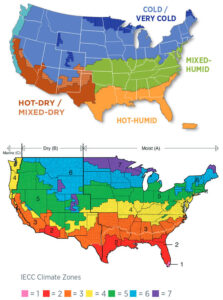
- Michigan
- Colorado
- South Dakota
- Texas
- Nevada
- North Carolina
- Maine
This prejudice toward tiny houses is counter intuitive in that 40 percent of people over the age of 50 are interested in buying an off grid tiny house, and 63 percent of people aged 20 to 30 are thinking of buying one.
Space
The best tiny homes are almost the size of a small hotel room. Even in these cases, narrow hallways and stairs are something many people must get used to. Additionally, being in close contact with other family members is something many people have never actually experienced, so arguments can erupt – especially when you are off-grid and cannot disappear to the local shops for a few hours!
Local Ordinances
Some cities outlaw property being used for homes smaller than 800 square feet. Others require homes to be a minimum of 1,000 square feet. According to current data, the average off grid tiny house offers between 240 and 600 square feet, making them too small to be legally parked on property.
Water Hoarding
In terms of self sufficiency, many cities are beginning to outlaw water hoarding. The logic is that water is a community resource. As a lone member of the community, you cannot hoard what partially belongs to others. Instead, the water is controlled by a city board, which can then ration the resource.
Planning
The best aspect of being off grid – independence – is directly related to one of its most difficult aspects: planning. For example, in addition to all the above considerations, it still requires planning to be completely off grid. In fact, an entire new way of thinking is often required.
For instance, people often look for communities that are friendly toward tiny homes. However, the best thing to do in terms of land is find up to 10 acres of remote property. This type of property should be outside city limits, which will reduce or eliminate your property tax.
Additionally, this size of parcel is enough to sustain a variety of small wildlife that you can legally take in season. For larger wildlife, such as deer, you will likely require up to 50 acres. In either scenario, you can raise a few cows, some rabbits, or chickens. Additionally, you can build a greenhouse for vegetables throughout the year.
In terms of water storage, this type of land will afford you the ability to drill a well, something that is illegal in city limits. Finally, if you select the right property, you can enjoy fruit trees, such as apple or cherry trees. With the right combination of an off grid tiny house and the right property, you can nearly eliminate any back and forth to grocery stores. Of course, this type of property can be difficult to find – and be quite expensive.
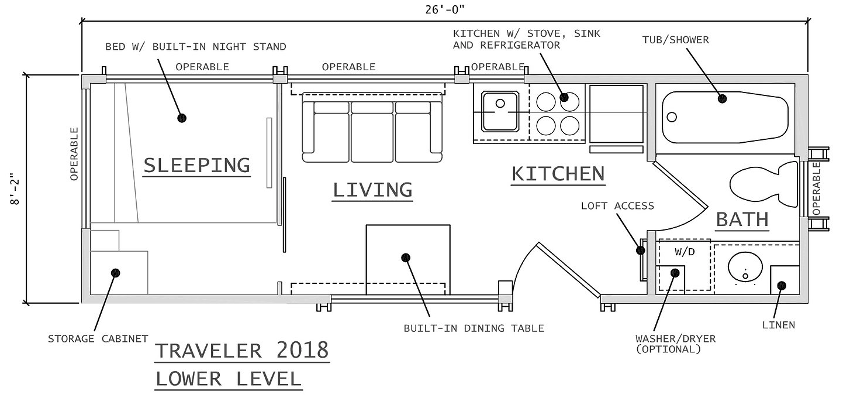
2 & 3 Bedroom Tiny House Plans Roundup: Great For Families
When some people think of tiny houses, they think of a small 16’ ‘cabin on wheels’ which has a single bedroom space that is fine for single people and couples, but clearly not fine for growing families with children. Equally you might not have $90,000 spare to buy a larger tiny house from a mainstream tiny house builder, so what are your options?
It’s worth looking at tiny house plans which specifically cater for 2 or 3 bedrooms, since these are designed with growing families in mind. Our roundup covers loads of perfect floor plans which you can build from (or hire out to get built).
(more…)